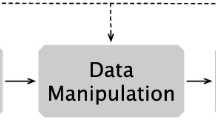Abstract
Debate has long been a hallmark of the academic endeavor. The recent introduction of computers into academic life has not been the deus ex machina to bring sudden resolution to these debates. There is a new computing technology, however, that has some promise in this regard. It is called conceptual modeling. This paper' demonstrates how a computer-based model of a problem domain can lead to consensus when competing approaches to the domain can be encapsulated in different visual models that are applied to the same underlying conceptual model.
Similar content being viewed by others
References
Bihlmeyer, K. ‘Zweiter Klemensbrief’, in Die Apostolischen Vaeter, Erste Teil (Tuebingen, J. C. Mohr) (1970), 71–81.
Borgida, A. ‘Features of Languages for the Development of Information Systems at the Conceptual Level’, IEEE Software 2(1) (1985), 63–72.
Faulhaber, C. B. ‘Textual Criticism in the 21st Century’, Romance Philology 45(1) (1991), 123–48.
ISO. Information Processing — Text and Office Systems-Standard Generalized Markup Language (SGML), (1986), ISO 88791986 (Geneva, International Organization for Standardization).
Knuth, D. E. The TEXbook, Volume A of Computers and Typesetting(1986), (Reading, Mass., Addison-Wesley).
Kucera, H. and Francis, W. N. Computational Analysis of Present day English (1967), (Providence, Brown University Press).
Lake, K. ‘The Second Epistle of Clement to the Corinthians’, in The Apostolic Fathers, volume 1 (1912), 123–63. Loeb Classical Library (Cambridge, Harvard Univeristy Press).
Langendoen, D. T. ‘Feature Structures’, chapter 18 of Sperberg-McQueen and Bumard (1994).
Leech, G. ‘Corpus Annotation Schemes’, Literary and Linguistic Computing 8(4) (1993), 275–281.
Lightfoot, J. B. “The So-called Second Epistle of S. Clement’, in The Apostolic Fathers: Clement, Ignatius, Polycarp (2nd edition), part 1, volume 2 (1890), 191–268 (London and New York, Macmillan). (Reprinted 1989 by Hendrickson Publishers, Peabody. Mass.)
Rettig, M., Simons, G., and Thomson, J.‘Extended Objects’, Communications of the ACM 36(8) (1993), 19–24.
Simons, G. (forthcoming, a), ‘Multilingual Data Processing in the CELLAR Environment’, to appear in Nerbonne, J. (ed.), Linguistic Databases (Stanford, Center for the Study of Languages and Information).
Simons, G. (forthcoming, b), ‘The Nature of Linguistic Data and the Requirements of a Computing Environment for Linguistic Research’, to appear in Lawler, J. and Dry. H. (eds.), Computers and Linguistics: A Practical Guide (Routledge).
Speer, M. B. ‘Editing Old French Texts in the Eighties: Theory and Practice’, Romance Philology 45(1) (1991), 7–43.
Sperberg-McQueen, C. M. and Burnard, L. Guidelines für the Encoding and Interchange of Machine-readable Texts (1994) (Chicago and Oxford, Text Encoding Initiative).
Wengst, K. Didache (Apostellehre), Barnabasbrief Zweiter Klemensbrief, Schrift an Diognet (Munich, Koesel-Verlag) (1984), 205–80.
Author information
Authors and Affiliations
Additional information
I am indebted to many for making the research reported herein possible. Terry Langendoen and Dominic Dunlop assisted materially in providing the data files for the tagged text example. Robin Cover has played a crucial role as provider of inspiration, tutelage, and source materials for the example from textual criticism — a domain which falls outside my own area of expertise. John Thomson has collaborated in the design of CELLAR ever since the idea was conceived late in 1987. He has also led the team of Smalltalk programmers who began working in 1990 to implement CELLAR. Members of this team (listed with length of service) have included: Larry Waswick (5 years), Sharon Correll (4 years), Marc Rettig (2 years), Jim Heimbach (2 years), Nathan Miles (18 months), and David Harrison (9 months). The development of CELLAR has been funded in large part through a grant from Wycliffe Bible Translators (Huntington Beach, California).
Rights and permissions
About this article
Cite this article
Simons, G.F. Conceptual modeling versus visual modeling: a technological key to building consensus. Comput Hum 30, 303–319 (1996). https://doi.org/10.1007/BF00115139
Issue Date:
DOI: https://doi.org/10.1007/BF00115139




